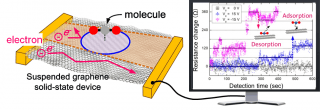Apr 18 2016
A graphene-based switch and sensor has been developed by a group of scientists from the University of Southampton in collaboration with the Japan Advanced Institute of Science and Technology (JAIST). This invention will help to detect harmful air pollution in extremely low power consumption homes.
 A diagram of a graphene single molecular sensor (left) and the observed signal showing successful detection of single CO2 molecule adsorption / desorption events.
A diagram of a graphene single molecular sensor (left) and the observed signal showing successful detection of single CO2 molecule adsorption / desorption events.
This new sensor detects volatile organic compound (VOC) gas molecules and CO2 molecules present in interior materials, furniture, buildings, and also household goods, which majorly affects living in modern homes built with good insulation.
All of these hazardous chemical gases have low parts per billion (ppb) concentration levels and cannot be easily detected with the existing environmental sensor technology, which is only capable of detecting concentrations of parts per million (ppm).
The existence of polluted air in personal living spaces has led to the development of health problems, such as the sick building syndrome (SBS), sick school syndrome, and the sick car syndrome.
The research team, headed by Professor Hiroshi Mizuta, who holds a joint appointment at the University of Southampton and JAIST, and Dr Jian Sun and Assistant Professor Manoharan Muruganathan of JAIST, invented the sensor to detect CO2 molecules adsorbed onto the suspended graphene. The team applied an electric field though the structure to detect the molecules one by one. The individual CO2 molecules refer to the binding of molecules from a gas to a surface. The suspended graphene refers to a single atomic sheet of carbon atoms organized in a honeycomb-like hexagonal crystal lattice structure.
The adsorption and desorption processes (releasing of a substance through or from a surface) of each CO2 molecule onto the graphene were identified as ‘quantised’ changes in resistance (step-wise decrease or increase in resistance). The researchers arrived at this result by examining the graphene beam’s electrical resistance. In a study, published on April 14th, in Science Advances, the journal of the American Association for the Advancement of Science (AAAS), a minimal quantity of CO2 gas was released. This amount of gas was equal to concentration of about 30 ppb, and the detection time took only a few minutes.
In contrast to the commercially available environmental monitoring tools, this extreme sensing technology enables us to realise significant miniaturisation, resulting in weight and cost reduction in addition to the remarkable improvement in the detection limit from the ppm levels to the ppb levels.
Professor Hiroshi Mizuta, University of Southampton, JAIST
Research group members, Dr Harold Chong from Southampton and Dr Marek Schmidt and Dr Jian Sun of JAIST, have also recently created graphene-based switches using novel thin film produced at the University of Southampton. This invention features in the March issue of Nanoscale, the journal of the Royal Society of Chemistry.
The graphene-based switches, which need extremely low voltages below three volts, are capable of being used to power electronic components and also enhance the lifetime of batteries used for personal electronic devices.
Professor Mizuta and the research group are currently aiming to combine the two technologies to develop ultra-low-power environmental sensor systems capable of detecting single molecules.